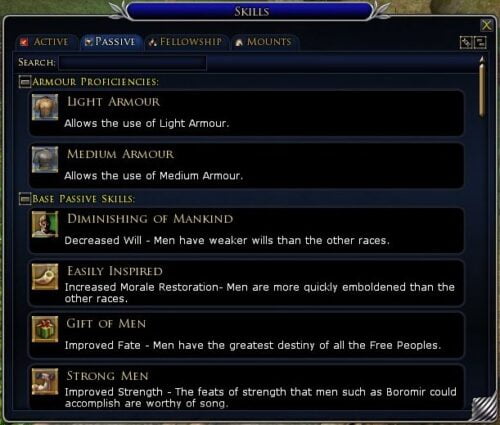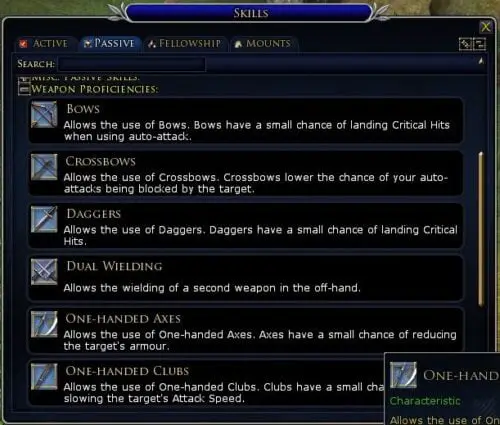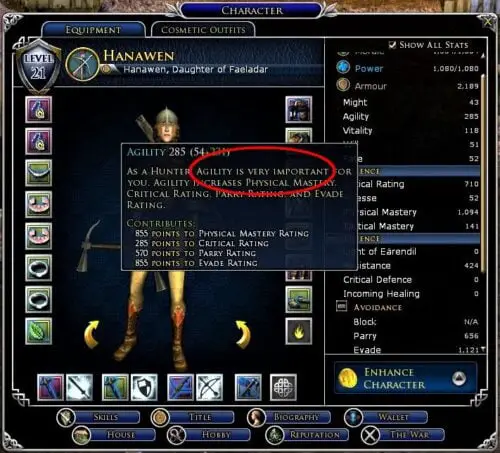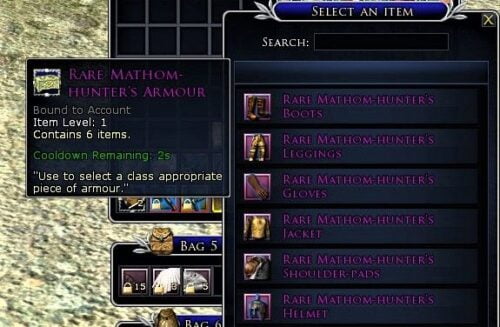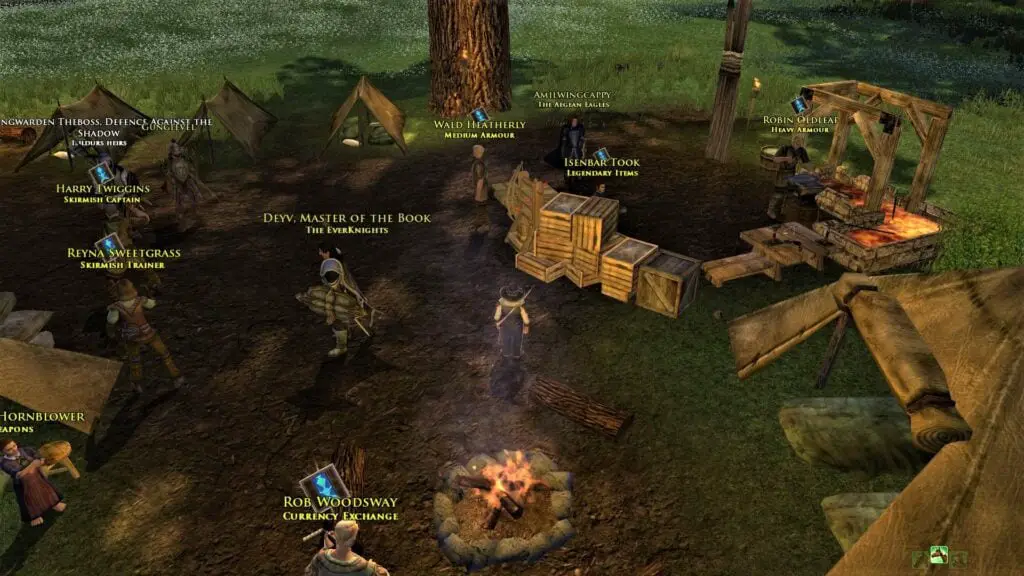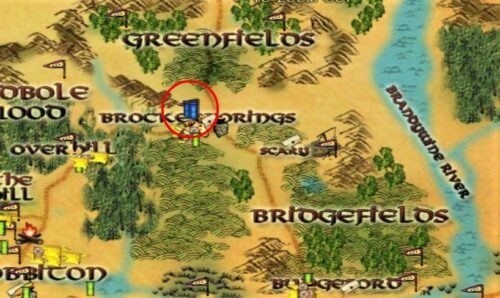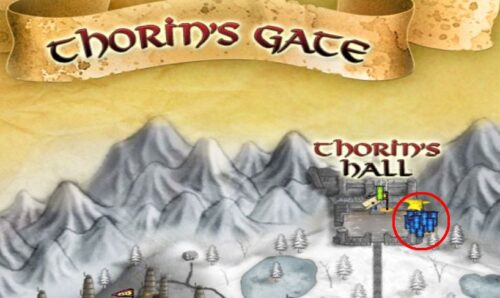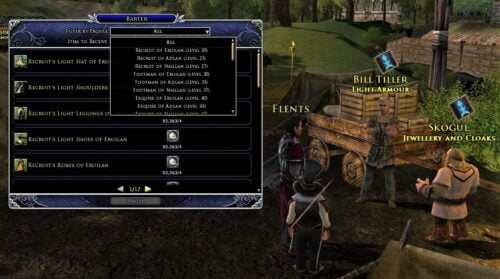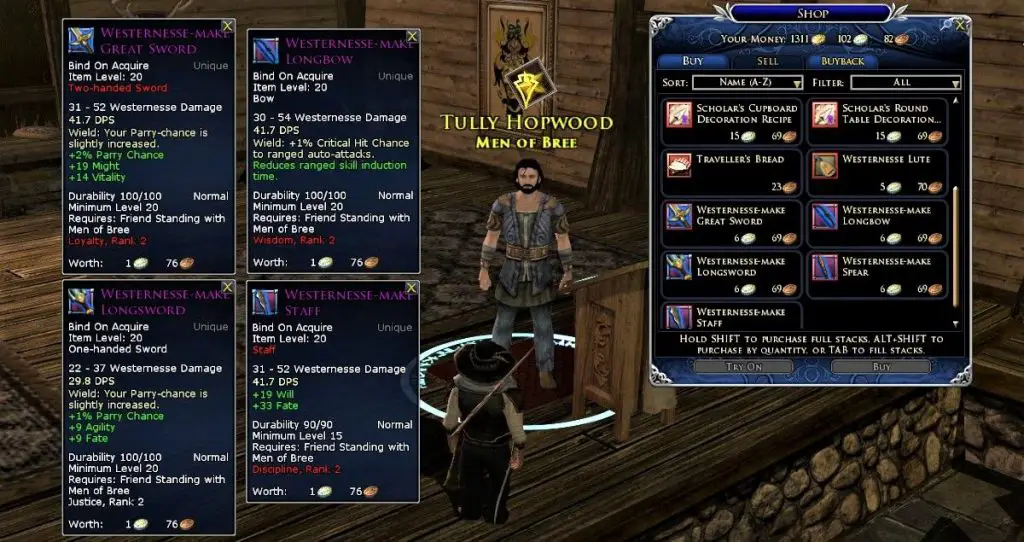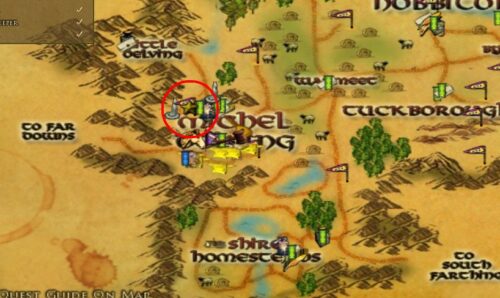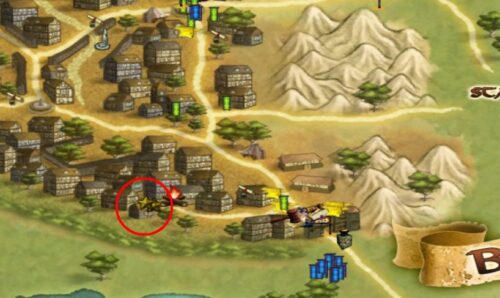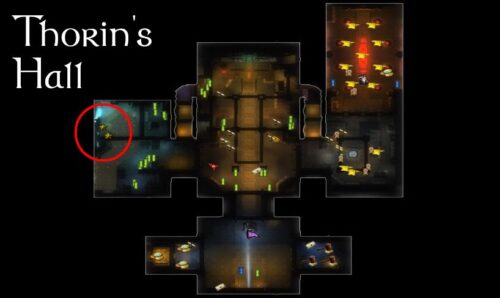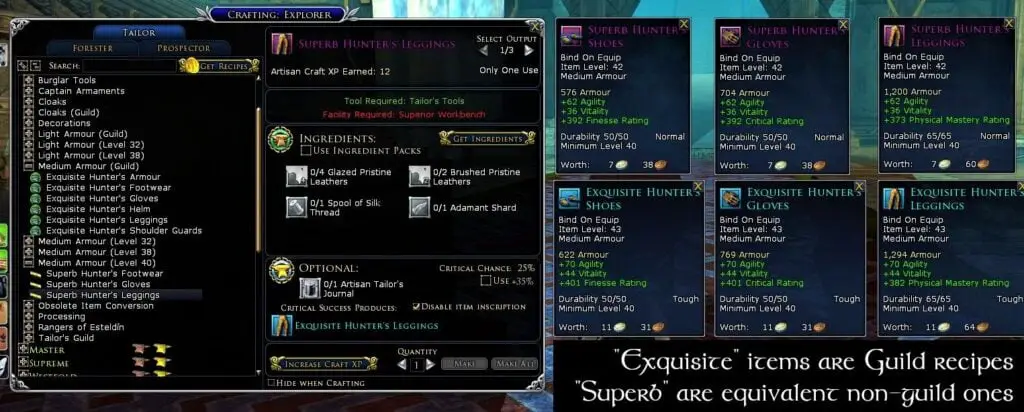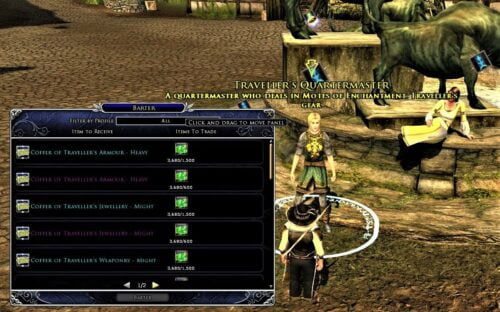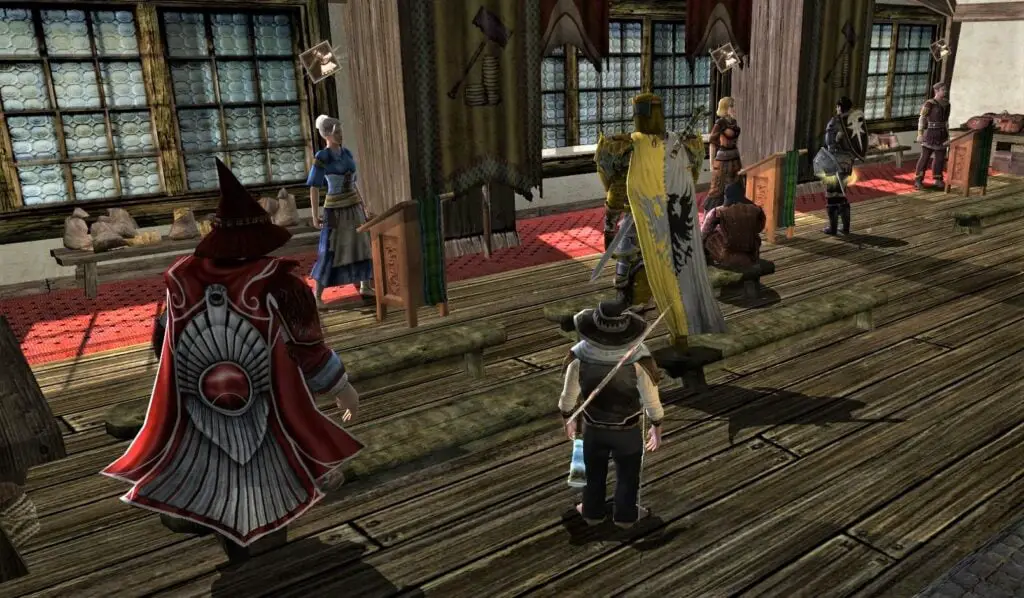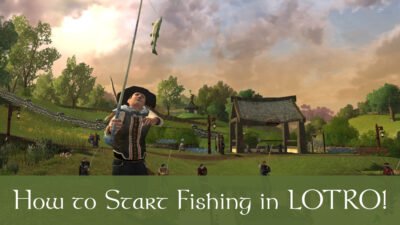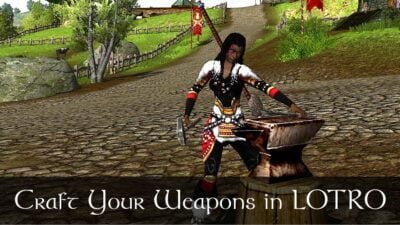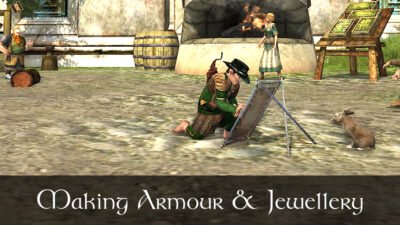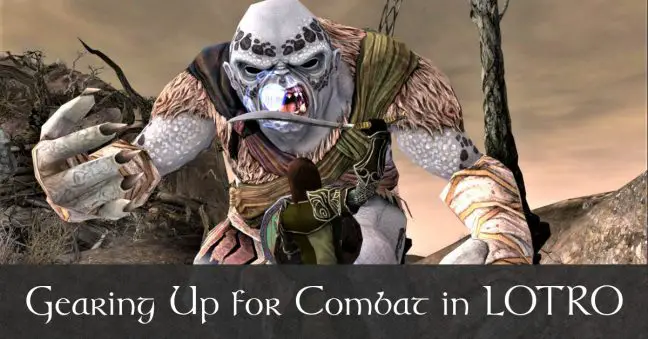
Post Sections ⇅
- What is “Stat Gear”?
- What Type of Gear Do I Need in LOTRO?
- Where Do I Get Gear Upgrades From?
- Other LOTRO Gearing Options
- TL;DR No Shortage of LOTRO Gearing Options! Go Get ’em!
What is “Stat Gear”?
Stat Gear is a term I use, but doubt others do, to describe armour, equipment and weapons that help you in combat. Your character, those of other players, and the foes you fight are governed by numbers and statistics. Stat Gear excludes items used for cosmetic reasons only when making LOTRO Outfits, whether from cosmetic items or gear used through the Wardrobe function.
Precisely Which Bits are “Gearing”?
From the above definition, gearing is what you have in the square slots around your character’s avatar in the Character panel. Make sure you have the “Equipment” tab selected at the top, as the other one is “Cosmetic Outfits”, which only change your appearance and does not affect your combat performance.
The combat gear slots are:
- Jewellery
- Earrings × 2
- Necklace × 1
- Bracelets × 2
- Rings × 2
- Armour
- Head
- Shoulders
- Back
- Upper Body
- Hands
- Legs
- Feet
- Weapons
- Main Hand: where your primary weapon goes, except for Hunters, whose primary weapon is in the Ranged slot.
- Off-hand: where a second weapon or shield can go, if you’re not using a two-handed weapon.
- Ranged Weapon: a weapon such as a bow or javelin (class and level dependent).
- Class Slot: Until Moria, whether you can fill the class slot with anything is determined by your class and level. In theory you can mostly ignore the class slot (except Rune-Keepers, I believe) until Moria, but equipping something here will aid you in combat. Example items are (links go to the Wiki for more info):
- Pocket × 1
There is also a slot for your crafting tools.
What Type of Gear Do I Need in LOTRO?
The type of equipment you require will be determined by your class. As a note, most cloaks are Light Armour, regardless of your main armour proficiency. Also ranged ‘weapons’, for some classes, may not seem like a weapon at all!
- Beorning: Heavy Armour, two one-handed or one two-handed melée weapon, Bow or Crossbow
- Burglar: Medium Armour, two one-handed melée weapons.
- Captain: Heavy Armour, various one- and two-handed melée weapons, shield (if not using a two-handed weapon), Captain Armaments or Banners
- Champion: Heavy Armour, various one- and two-handed melée weapons, bow
- Hunter: Medium Armour, Bow or Crossbow, Various melée weapons
- Guardian: Heavy Armour, various one- and two-handed melée weapons, shield (if not using a two-handed weapon), Bow
- Lore-Master: Light Armour, two-handed staves, one-handed sword (from Level 40), Lore-Master Brooches (a Jewellery Crafting recipe)
- Minstrel: Light Armour, one-handed weapon (main hand) and shield (off-hand), musical instrument
- Rune-Keeper: Light Armour, Rune-Stones (a two-handed weapon), Riffler/Chisel (Ranged Weapon)
- Warden: Medium Armour, Various melée weapons, Warden Shields, Javelin (Ranged Weapon)
How to Find Your Armour and Weapon Proficiencies
To see which types of armour of weapons you can equip open the Character Panel and press the Skills button. Armour proficiencies are at the top of the list and weapon proficiencies are at the bottom.
This does mean you can equip armour that is equal or less than your highest option.
- Light Armour classes can only use Light armour
- Medium Armour classes may equip medium and/or light armour
- Heavy Armour classes are able to use all three grades.
Which Stats Should I Focus On First?
To keep it simple, just look in the Basic Stats section in the top right of the Character Panel. Hover over each of the five and see which two are Very Important and Important. If you can get gear for those two stats then great! If not, then put something in the gear slots with other stats – any improvement will help you.
For the avoidance of doubt, prioritise Very Important, then move onto Important.
Vital Stats for Classes in LOTRO
But as a quick guide to the priorities:
- Burglar, Hunter & Warden: Agility, Vitality, (Physical Mastery)((In the earlier levels you don’t need to worry about Physical Mastery.))
- Beorning, Captain, Champion & Guardian: Might, Vitality, (Physical Mastery)
- Lore-Master, Minstrel & Rune-Keeper: Will, Vitality, (Tactical Mastery) ((“Magic” based classes, (maybe Beorning Healers?) benefit from Tactical Mastery, but you don’t need to think about this for quite a long time. Just focus on your core stats.))
Where Do I Get Gear Upgrades From?

The main places are: loot drops, quest rewards, Skirmish Camps, Reputation Vendors, Class Quests, Crafting and the Auction House. I also cover a few other options too. In short, a lot of places! For most I’ve tried to provide pros and cons. In all likelihood, your gear will end up coming from a combination of a range of sources.
Loot Drops and Quest Rewards
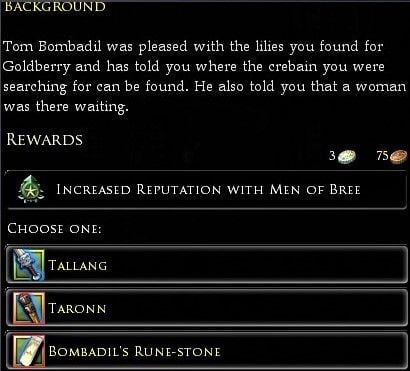 The first two places you’ll get your equipment from are loot drops and quest rewards. Loot drops are when a defeated foe provides you with an equippable item. These go into Pending Loot (bottom right of your screen) before being transferred to your bags. You can then equip items from your bags either by right-clicking it or dragging the item to the correct slot on the Character Panel.
The first two places you’ll get your equipment from are loot drops and quest rewards. Loot drops are when a defeated foe provides you with an equippable item. These go into Pending Loot (bottom right of your screen) before being transferred to your bags. You can then equip items from your bags either by right-clicking it or dragging the item to the correct slot on the Character Panel.Advantages
- Loot drops and quest rewards happen naturally as a result of normal adventuring.
- Unlike quest rewards, loot drops are not bound until you equip them. This means you can save anything that another character of yours could benefit from, now or in the future.
- These sources do not cost any in-game coin, and selling them to a vendor will result in extra silver/copper for your character.
Disadvantages
- Loot drops are random, and appear relatively rare, so cannot be relied upon. See these are “bonus extras”.
- The level of loot is based on the level of the enemy you defeat which may be under your current gear level
- Most quests do not have rewards for all classes (or trait lines)
- You have to keep an eye on pending loot so you don’t lose any items you need.
- It’s hard to control your combat stats this way, especially if you’re trying to boost a “non-focus” stat.
What is Mathom-Hunter’s Armour?
Sometimes loot will include a box called Rare Mathom-Hunter’s Armour((There is also an Incomparable Mathom-Hunter’s Armour box, which grants stronger stats than the “Rare” one. Ironically, the “rare” ones drop fairly often and the Incomparable ones rarely drop!)). This box can be opened at any time and allows you to select one piece of armour for your character. The items scale to your character’s level, so you can save them for later. While usually pretty strong, in the lower-levels at least, Crafting Your Gear usually yields better combat stats.
Use Loot/Rewards as a Bonus, but not Your Focus
In short use loot/rewards as a supplement to your current gear. Though in the early regions, quest rewards may be how you get your initial gear set.
Skirmish Camp Gear
Outside many main towns and settlements across Middle-Earth you will find Skirmish Camps. It is here you will need to train your Skirmish Soldier if you play these instances((Skirmishes are optional extras until Moria where you will be required to undertake a few of these. The same applies to the Mirkwood epic.)). But that’s not all, because there are many vendors here too.
Combat Gear Available at Skirmish Camps
As this is a beginners guide, I will just draw your attention to the main ones:
- Jewellery and Cloaks, which also includes Pocket items
- Weapons
- Light, Medium and Heavy Armour Vendors
- As a side-note, you can also trade Marks and Medallions for cosmetic clothing at Skirmish Camps too.
Skirmish Camp Locations
In the earlier regions, Skirmish Camps can be found:
- Ered Luin: outside the great doors of Thorin’s Hall in Thorin’s Gate
- The Shire: In Brockenborings, North of The Plough and Stars
- Bree-land: outside the South gate of Bree
Advantages
- You don’t need to use Gold/Silver to purchase items
- Items may be stronger than you get for equivalent loot drops or quest rewards
- You can easily obtain gear items you cannot craft for yourself.
- If you do deeds (e.g. Deeds of the Shire) for LOTRO points, your Marks will increase anyway, so you can benefit in two ways from one activity.
- Once you hit Level 50 and your character has opened the door to Moria, you can purchase Legendary Weapons at the Skirmish Camp.
- You can mix-and-match gear types if you want greater control over your combat stats.
Disadvantages
- You can only start using gear from Skirmish Camps from Level 20. However this is a level easily attainable part way through Bree-land questing!
- You need to earn marks from skirmishes or by completing deeds. This means the currency can take time to build up.
- At higher levels you may need Medallions. This can be earned from Skirmishes (and the daily Yule Fest box, in fact). But if you don’t have Medallions (also called Medals) the exchange rate from Marks to Medals to acquire these is extortionate!
- Skirmish Camp gear not available for all levels, but are typically every three levels or so. See the screenshot below.
Reputation Vendors
From the very first region you explore, you are earning reputation with “factions”: The Mathom Society (The Shire), The Men of Bree (Bree-land) and Thorin’s Hall (Ered Luin). Each of these has Reputation Vendors, who offer a variety of goods. What is available for purchase depends on your current Reputation standing with that faction. While not all Reputation Vendors have stat gear, many do.
Finding a Reputation Vendor
To see where the area’s reputation vendors are, open your Map. Then click the Drop-down filter menu and ensure Faction Representative is ticked. Now, you can find the Reputation Vendors by looking for the little star icons. For the first three regions, here is where they are:
- Ered Luin: Blue Stone Garrison – inside Thorin’s Hall, West wing and up the stairs
- The Shire: The Mathom House, Michel Delving
- Bree-land: Hunting Lodge, Bree
Advantages
- Reputation items are often fairly low coin-cost. Many are purchased by using a local currency (e.g. Evendim), so don’t cost you Gold/Silver at all.
- Some reputation gear (purchasable or craftable) has unique cosmetic appearances that you cannot craft in any other way.
Disadvantages
- Many of the better gear items (or crafting recipes) are locked to Ally or Kindred standing. This can take a long time, at which point you may have out-levelled the options available.
- Not of that all classes (or trait trees) are represented at reputation vendors.
- Some reputation items may require a certain Virtue Trait at a particular level. So it’s possible you may not be able to equip it anyway.
- Reputation gear cannot (understandably) be purchased for alts it’s Bind on Acquire.
- If it’s a reputation crafting recipe you can’t create an item for another character who doesn’t have the required standing to equip it.
Class Quests
This one is really brief, but Class Quests do crop up at various levels and often (but not always) result in new gear.
Advantages
- They tend to be pretty-powerful items.
- They are the result of following a class-related story.
Disadvantages
- You may be presented with two amazing items but only able to choose one.
- Class quests are infrequent.
- Level 50 class quests take a long time to complete.
However you should complete your class quests. They are well-written stories, tick off class deeds and may be accompanied by a trait point. So even if you’ve out-geared the equipment rewards, there are solid reasons for engaging with them!
↑ Section Menu
Crafting Your Gear

Crafting is the ability to make stat gear yourself, for your characters or for other players. If you’re relatively new to playing LOTRO, please check out my Beginners Guide to Crafting in LOTRO.
The following professions craft combat gear (though they do other things too):
- Tailor: Light and Medium Armour, and Cloaks.
- Metalsmith: Heavy Armour and Shields.
- Woodworker: Wooden weapons such as clubs, staves and spears.
- Weaponsmith: Mostly metal weapons, like swords and axes.
- Jeweller: Makes your jewellery (earrings, necklace and bracelets) and pocket slots.
Guild Crafting
Crafting guilds in LOTRO can be joined once you reach Expert level in your crafting profession. Through a slightly more complicated making process, higher-grade items can be made compared to non-guild recipes.
For more information on crafting guilds see my guide here.
Advantages of Crafting
- Crafted items are pretty-much always better than on-level quest rewards and often of a higher grade than Skirmish Camp options. This makes it a solid LOTRO Gearing choice for your character.
- At lower levels, many armour items (medium or heavy) have higher combat stats than even Mathom-Hunters armour.
- At higher levels, crafting can give outfit appearances you cannot obtain elsewhere in the game.
- You have a relatively-high level of control over the mix of combat stats.
- You can gear up before hitting on-level content rather than pushing through on-level quests for rewards.
- You can craft items for your other characters and for other people.
- If you have Armourer, Tailoring, Jeweller and Weaponsmith, Woodworker crafters, you can totally gear yourself out. Armourers have a Tailor line and Weaponsmiths can also be Woodworkers. So long as you have a Prospector and Forester in that mix, you can, in theory create a complete set of combat gear with just three characters.
- Guild items can be good enough for a ten-level range, so you don’t need to replace them often.
Disadvantages
- Gathering and crafting takes a lot time. Though this is also a relaxed way to play to balance out all that combat.
- You may have to keep a lot of crafting materials in your bags or vault. This could mean spending LOTRO points on increasing those storage spaces.
- You can only gear your highest-level character if you can obtain all the materials for that level. This is why, on Crickhollow, I have an Explorer main. Explorers can mine ore and cut wood, as well as process hides and logs.
- If you do guild crafting, making a complete set for one character could take a week due to cooldowns. This is not the case for lower-levels, but certainly from Artisan/Master it is.
- Increasing crafting guild reputation takes a lot of time and effort. And you have to remember to craft the reputation items too.
Gear Boxes from Bree Fountain
The Adventurer’s Quartermaster by the Bree Fountain has a range of boxes for purchase.
These boxes scale to your level regardless of when they are opened. And all classes are covered, granting generally awesome stat-gear for you to equip straight away.
The main downside is you need Motes of Enchantment (and much later, Embers of Enchantment) to purchase them. The easiest way for players to earn Motes of Enchantment is by completing certain deeds.
From Lovely Kin Folk
I can honestly attest to how awesome it is being in a supportive Kin. If you play your part and socialise through Kin Chat, people will often be willing to craft items for you. They may occasionally ask for you to grab some materials, but hey, that’s teamwork.
Naturally, if you undertake fellowship quests with kinfolk, you have the chance of loot upgrades too.
If you’re not in a Kin and would like to be, then visit the Kin Forum on LOTRO.com, tweet @lotrofamily or post to the LOTROfamily Facebook Group.
↑ Section Menu
Auction House & Other Auctioneers
Where Are the Auctioneers?
To find a local auctioneer, look for the hammer icon on the map or minimap/radar:
The first three Auction Houses you’ll come across are:
- Thorin’s Hall: Through the main doors and turn right.
- Michel Delving: Near the market stands.
- Bree: Bree Auction Hall, also Bree-town Vault and the Crafting Hall.
Using the Auction UI to Find Gear
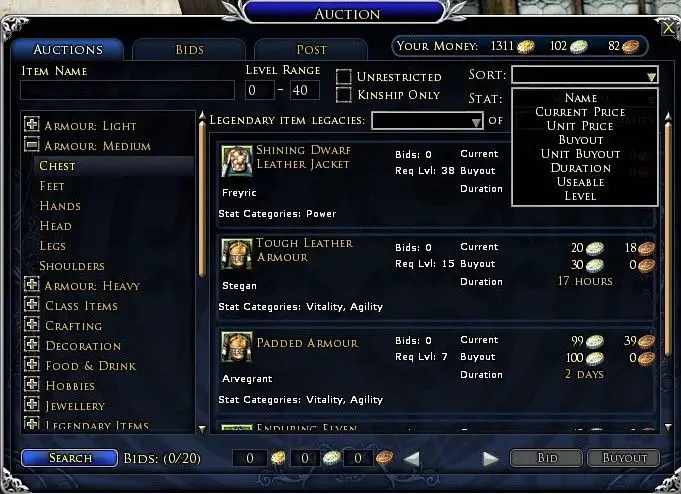 The Auction UI window may appear complicated, but it’s not really. Here’s a rough and ready run down:
The Auction UI window may appear complicated, but it’s not really. Here’s a rough and ready run down:- Down the left you can choose what sort of item you’re looking for. Here I’ve selected Armour: Medium → Chest
- At the top are two Level Range boxes. Pop in a minimum level in the left box, and a maximum level in the right box. Or put your current level less 2 or 3 levels in the first box and put your current level in the second box.
- Hit Search
- You will then want to decide what is relevant for you. So let’s sort the results. As you’re looking for gear here, the main two options you need are Current Price and Buyout. Buy out is “Buy it now”, but look at the price difference between Current and Buyout before making that decision.
- You can choose whether to bid on an item, putting you in a price ‘battle’ if others are interested in the same item. If no one else is bidding on it, it may save you some funds to big rather than buy out. The risk is not getting the gear you want. But some Buyout prices are only marginally more than the Current Price. In that case, if you have funds, it can be less stressful to buy it outright.
Advantages
- You are able plug gaps in your crafting
- You can purchase things with gold/silver/copper, not any special currency or tokens.
- It is easy for you to acquire gear that you don’t have the materials to create.
- You can choose to purchase the materials rather than go gather them
Disadvantages
- You are at the ‘mercy’ of someone else’s prices. But as I said, not everyone overprices things. So be prepared to engage brain and get the bargains.
- You can’t rely on it to have specific things you need. I do check AH periodically for my lower characters but it’s not often that what I need is for sale.
- Auction house is a bidding system (clue’s in the name, yes?). So you need to either visit the Auction House frequently, park there, or “Buy Out” (usually a higher price to the current bid price).
Other LOTRO Gearing Options
Phew! As you can see, you have a wide array of options for preparing your characters for battle. But there are other a few other avenues too.
- Bingo Boffin: The Bingo Boffin questlines often have the odd piece of gear at the vendors. I would say you should run Bingo Boffin alongside the Epic anyway. It contains some fab storytelling and you can often pick up cosmetic pets unobtainable in other locations. How to Start Bingo’s Story →
- Group Content: Fellowship content, Instances, Raids etc to gain gear, loot and quest rewards
- Paid-for (with real money) lockboxes (require LOTRO Store Black Steel Keys). However, these boxes are random content, so you may not get gear you need.
- An Option but not Really: In various towns in Middle-Earth are armour and weapon vendors. You can use these but realistically they aren’t any good. The items usually have an armour value but not any of the stats. So only use these if you’re desperate, or don’t craft.
TL;DR No Shortage of LOTRO Gearing Options! Go Get ’em!
As I said near the beginning of this LOTRO Gearing Guide, at various points in your adventures you’ll have a mix of combat equipment. One of my lowest characters has a mix of crafted items, quest rewards and Skirmish Camp purchases. And this is okay. Mix and match as you feel comfortable doing. Above all, enjoy your adventures in Middle-Earth – but make sure that you “Prepare for Battle” before wading into an army of Orcs, mkay?!
